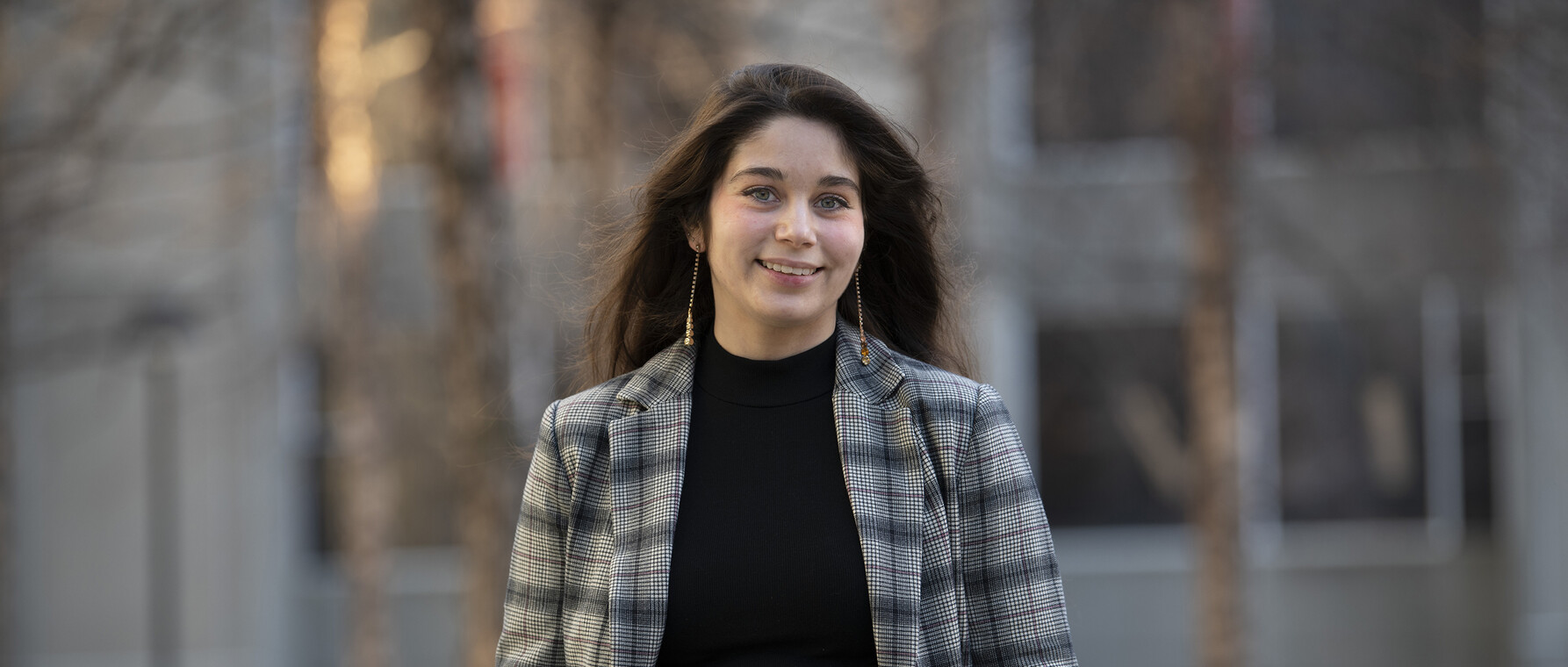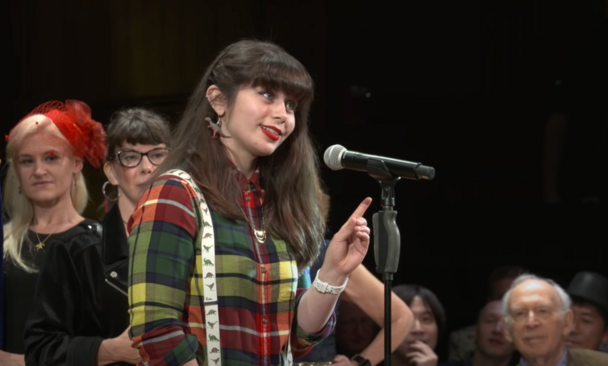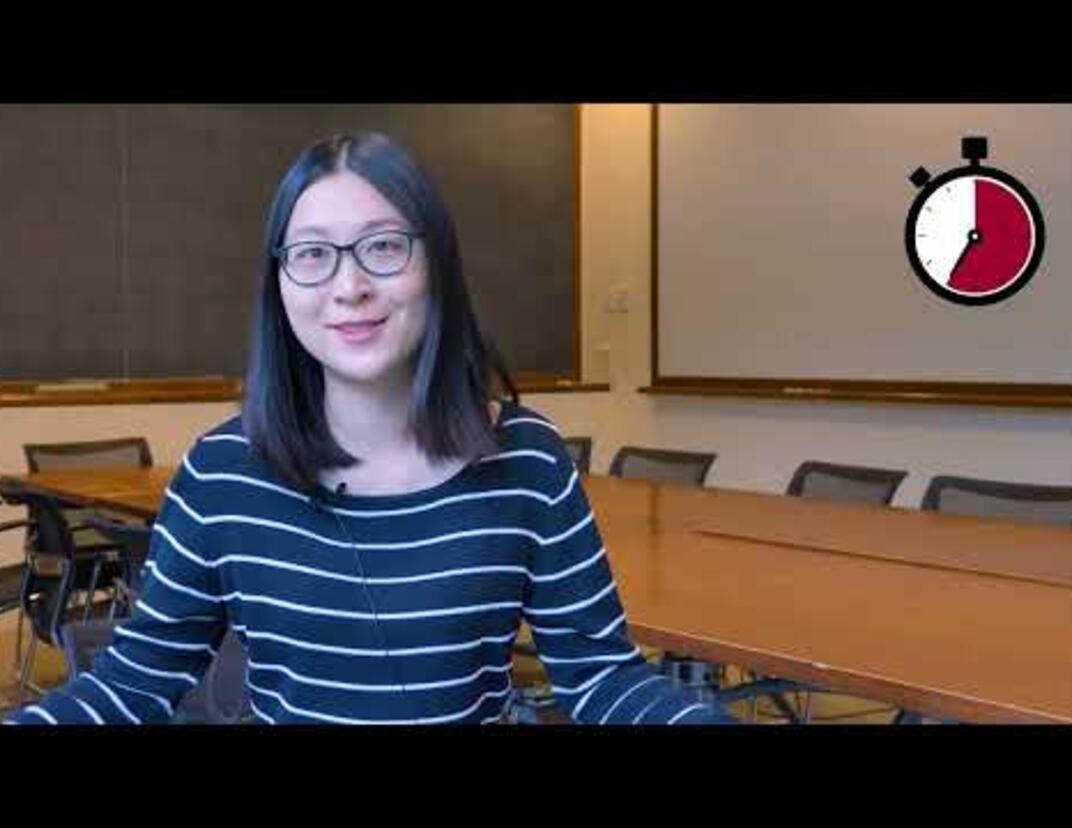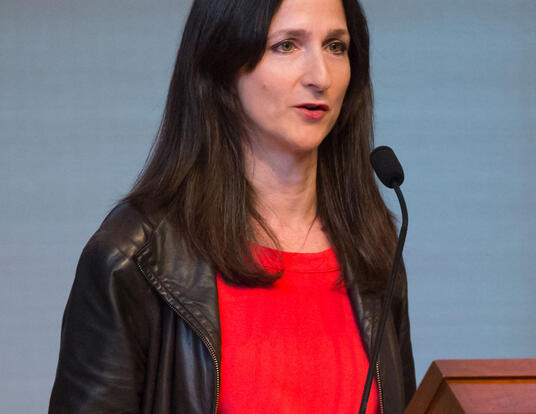Like a Rocket
Cesarotti brings high energy to the search for a new physics

Research at Risk: Since World War II, universities have worked with the federal government to create an innovation ecosystem that has yielded life-changing progress. Now much of that work may be halted as funding is withdrawn. Find out more about the threats to medical, engineering, and scientific research, as well as how Harvard is fighting to preserve this work—and the University's core values.
Cari Cesarotti still remembers the guilty fun of the day a rocket launch went awry. She was attending elementary school science camp. The teacher, Mr. Jensen, lit the fuse on her cardboard and plastic model as she and her classmates watched it rise higher into the sky than they had anticipated. The toy parachute deployed and was carried off by a gust of wind, landing on the roof of a nearby house. Her group crept up stealthily on the house to retrieve the toy and found that it had come to rest on a bush out front.
“It was me and a bunch of other seven-year-old kids and our 30-year-old teacher,” she says. “It was this weird heist, stealing my model back out of someone’s yard so we don’t get yelled at. It was a thrill. I mean, when you’re a kid lighting off rockets, well, what else do you want in life?”

Like her rocket, Cesarotti has traveled farther than she thought she would since her days as a kid in Chicago: to Cornell University for a BA in physics; to the Large Hadron Collider at the Conseil Européen pour la Recherche Nucléaire (CERN) where she helped search for new particles; and now to Harvard’s Graduate School of Arts and Sciences, where she studies for her PhD in physics at the University’s Center for the Fundamental Laws of Nature. At each stop, she’s brought the same sense of joy and wonder to the study of high energy physics that she had that day in science camp.
Beyond the Standard Model
It wasn’t a given that Cesarotti would end up a research scientist. She initially identified engineering as her career path.
“In high school, it seemed like you could only be ‘successful’ if you were a doctor, a lawyer, or an engineer,” she says. “So, I thought I’d go to school and pursue a career in engineering.”
Both school and career took a sharp turn, though, when Cesarotti enrolled in her first physics class. She realized that her choice to be an engineer stemmed from her passion for learning about how the world—and eventually the universe—worked. She decided to become a research physicist, enrolled at Cornell University’s College of Arts and Sciences, and never looked back.
“I was hooked” she says of her reaction to her first physics class. “I lived near Fermilab [the Fermi National Accelerator Laboratory] in the Chicago area, so I was somewhat aware that being a physicist was an actual job. Still, I knew basically nothing about what it meant to be a research scientist. I decided to go for it anyway.”
Her new path determined, Cesarotti found mentors in James Alexander, Csaba Csaki, and Maxim Perelstein—all professors in Cornell’s Department of Physics and all involved with work at the Large Hadron Collider (LHC) at CERN in Geneva, Switzerland. Cesarotti’s experience as a research assistant to Alexander and Perelstein served her in good stead when she took a similar position at CERN after graduation and joined a team of high energy physicists testing the Standard Model of the universe.
“The Standard Model is the catalog of fundamental particles that physicists have discovered so far,” Cesarotti explains. “These are leptons, quarks, and bosons. High energy theoretical physics is the study of these particles, their interactions with each other, and their properties. But it’s also the search for particles beyond the Standard Model—in a sense, the search for a new physics.”
At CERN, Cesarotti worked on an experiment called NA62. While the primary goal of the research was to measure how often a composite particle (in this case, a kaon) decays in a certain way, Cesarotti says that the small team she worked with was also on the hunt for new particles—and a new understanding of the origins of the universe.
“Particle physics is essentially the study of what the universe is made of, how it was made in the first place, and how it's held together,” she says. “While we have learned a huge amount in the last hundred years, we've also learned that there are holes in our knowledge. There are some unexplained phenomena in the universe that suggest there are new particles and forces that we aren’t yet aware of. At CERN, we try to find them by recreating the conditions of the very early universe, colliding particles together in the LHC to look backwards in time.”
What Cari has done is to produce a novel, efficient new way to quantify how isotropic an LHC event is,” he says. “This can become a powerful tool to help sort through vast quantities of data in search of rare events that might reveal new laws of nature that have previously been hidden from us.
-Professor Matthew Reece
Fishing for Particles
Today at GSAS and Harvard’s Center for the Fundamental Laws of Nature, Cesarotti’s dissertation research builds on her work at CERN and centers around a perplexing question: How do physicists find something that is only implied by the gaps in their knowledge—something so small that it’s almost undetectable? Scientists in other fields might use an electron microscope, bombarding a small object they want to see with smaller, more energetic electrons. But what if what you’re looking for is an energetic electron—or something even more minute?

“We essentially try to reconstruct what actually happens when two particles collide by the mess they leave behind,” Cesarotti answers. “For example, we can measure the charge of particles, and we can measure their momentum. We can measure how far the particles fly through material before they are stopped—think how lead shielding works against radiation. We can measure if the particle decays into other particles. In fact, when two particles collide, sometimes hundreds of particles can come out. It's a big mess.”
To sort through the “mess,” Cesarotti leverages the notion of “event shape observables.” Instead of trying to keep track of each individual particle after a collision, she looks at the shape the particles make and measures how much energy and momentum is emitted in different directions. “It’s like fireworks,” she says. “You don't care about an individual spark, but the total effect makes a recognizable shape.” Standard Model events look anisotropic—their momentum varies by direction. If the spray of particles is isotropic—if the momentum is uniform in all directions—then it might be a signal of a new particle.
“You could think about it like this,” she explains. “Let's say you’re a biologist looking to find a species of animal very different from mammals. Well, a great place to look for ‘not mammals’ is underwater. We want to look for the not mammal of particle physics, so we developed a tool—event isotropy. That's our metaphorical fishing pole.”
Professor Matthew Reece, Cesarotti’s dissertation advisor, says that experimental physicists are constantly on the lookout for new ways to sift through the trillions of collisions generated by the LHC in their search for something new. The highly isotropic events that Cesarotti studies could provide the first hints of a new “hidden sector” of unfamiliar particles.
“What Cari has done is to produce a novel, efficient new way to quantify how isotropic an LHC event is,” he says. “This can become a powerful tool to help sort through vast quantities of data in search of rare events that might reveal new laws of nature that have previously been hidden from us.”
Cesarotti’s ultimate goal is not only to contribute to a “new physics” built around the discovery of previously unknown particles, but also to bridge the gap between theory and experimentation in her field. She hopes that the tools she develops will enable scientists not only to imagine a new framework for understanding the universe, but also to see evidence of it right before their eyes.
“I think that physics should have connection to the physical world,” she says. “So, what I hope will come out of my research for the PhD and beyond, is that it will be accessible to experimentalists and inform the way we gather data in the future. Physics needs to be a conversation between the theorists who think about what could happen and the experimentalists who have this extraordinarily hard job of essentially recreating the big bang.”
Despite the fact that the process of collecting data for her research is painstaking—experiments can run for years on end—Cesarotti says she’s still having fun. The pleasure she gets from her doctoral work is different than watching a model rocket shoot into the air—something she still loves. It’s the feeling of being in on a secret and of seeing the universe in new ways.
“I’m learning about why the universe looks the way it does,” she says. “And where the universe doesn’t quite look the way we think it should, I’m proposing models to fill out that picture. What could be more fundamental—or more fun?”
Photos by Tony Rinaldo and Courtesy of Cari Cesarotti
Get the Latest Updates
Join Our Newsletter
Subscribe to Colloquy Podcast
Simplecast





